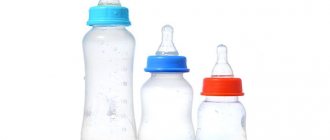Infant digestion
A newborn is constantly in a state of adaptation to new living conditions. Its organs and systems continue to develop, and the physiological mechanisms of defecation are also improved.
In an adult, the retention of feces in the rectum is ensured by involuntary and voluntary, that is, subject to the will, contractions of its muscles - the sphincters.
The urge to defecate occurs when stool comes into contact with the lower intestine. An adult is able to control the urge, but a newborn child is not.
The milk enters the stomach and triggers a gastrointestinal reflex, generating a wave of peristalsis throughout the gastrointestinal tract. Feces fall into the rectum and cause the urge to defecate. Not realizing that the conditions for defecation are, to put it mildly, unsuitable, the baby draws in his legs and strains. Emptying your bowels makes room for more food.
The frequency of stool in a newborn often coincides with the frequency of feedings, but it can be twice a day3. The feces have a yellow or yellow-brown color, sometimes with a greenish tint, a mushy consistency mixed with foam and inclusions reminiscent of cottage cheese, and the smell of sour milk.
Starting at about 2 months, the frequency of stools begins to gradually decrease. By the time complementary foods are introduced (by 4-6 months), most infants have bowel movements 2 times a day, and some - once every 2 days3. The feces thicken and take on a sausage shape - this is what all small children should have.
Up to contents
What should be considered constipation in an infant?
It is understandable that the lack of stool in a baby causes concern for parents and often becomes the reason for unnecessary self-medication. On the other hand, lack of basic knowledge about the proper frequency of bowel movements in children sometimes leads to delays in necessary treatment and complications. Therefore, first, let’s figure out what constipation is.
According to generally accepted opinion, constipation in babies under three months of age is considered to be a delay in bowel movements for 2-3 days. If difficulties with bowel movements persist for two or more weeks, they speak of chronic constipation.2,3. At the same time, the frequency of stool decreases (in comparison with individual characteristics3), the feces become dense, fragmented, and acquire an unpleasant putrefactive odor.
To empty the intestines, the child strains hard and for a long time, his face turns red, his legs are drawn up to his stomach. Sometimes the contents of the rectum are so hard that they injure the delicate mucous membrane and cause painful cracks to form. In this case, the baby cries, and a strip of scarlet blood appears on the surface of the stool.
Constipation affects the general condition of the baby. He experiences pain and bloating in the abdomen, popularly called “colic,” he eats poorly, becomes lethargic and moody.
It is the appearance of common symptoms of constipation in a breastfed newborn that serves as a guideline for diagnosis4. If they are absent, the child eats well, does not spit up, gains weight normally, the condition is considered to be “pseudoconstipation”, which does not require any intervention4.
Up to contents
What to do if your child is constipated?
When a child goes to the toilet quite rarely (no more than 2-3 times a week, but without blood in the stool and severe pain), and the stool is dense (type 1-3 according to the Bristol scale), then, first of all, you need to pay attention on his diet and level of physical activity. Add more fresh vegetables and fruits, cereals, dairy products to your diet, and analyze the amount of water you drink. It is important to ensure sufficient motor activity - this additionally stimulates perilstatics.
If the family first encountered a problem when the child did not walk “largely” for more than three days or bowel movements are not effective (i.e. the baby is in the toilet for more than half an hour, cries in pain and says that “I can’t poop”), then As an emergency, you can use an enema or rectal suppositories. It is worth clarifying that the currently popular microenemas have an exclusively local effect, i.e. if a small amount of feces has accumulated in the ampulla of the rectum, and constipation is no more than three days. If the problem is more “global”, it is necessary to resort to cleansing. There is nothing scary about this.
Take a syringe with a volume of 300–400 ml. Depending on the age, the volume of fluid administered will be different - this must be clarified with the pediatrician observing the baby, but approximately the volume is calculated using the formula: 1 kg of body weight = 20 ml of fluid. The liquid should be warm - approximately body temperature, i.e. 37 °C or slightly lower. Lubricate the tip with Vaseline or baby cream. The child needs to be laid on his left side and his legs pressed to his tummy (pre-calm him if he is scared). The tip is inserted into the anus with a gentle twisting motion towards the navel about 4–5 cm. Pour in the liquid slowly, carefully, while squeezing the baby’s buttocks.
Most likely, the child will say that it is difficult for him to hold back his feces and that he is about to “shit himself.” This is how it should be, warn him about this in advance. Pull the tip out of the anus and continue squeezing the buttocks with your hand. Do not let him sit on the potty or toilet for about 5 minutes - during this time the stool softens. Talk to your child at this time, distract him, you can turn on a cartoon. I repeat that these are extreme measures. You should not often resort to such intestinal cleansing, since it is almost always scary for the child. After enemas, children often begin to be afraid of even antipyretic suppositories! If your baby has frequent constipation, be sure to consult a doctor!
Recurrent constipation in a child is treated comprehensively. Treatment includes long-term use of laxatives followed by maintenance prophylactic doses, as well as behavioral therapy aimed at eliminating fear of bowel movements and establishing a bowel movement routine.
Why might a newborn be constipated while breastfeeding?
Difficult bowel movements and lack of stool in infants in 95% of cases are caused by various functional disorders in the intestines1,5. The remaining 5% is due to diseases that disrupt the formation, movement and excretion of feces1,5.
Organic constipation
This type of defecation disorders is most often detected in the first days or months of a baby’s life1,3. Its cause is anomalies in the development of the intestine and rectum in particular, various neurological diseases accompanied by slowing and incoordination of gastrointestinal motility, metabolic disorders against the background of reduced function of the thyroid gland and brain centers regulating the endocrine system, cystic fibrosis, Hirschsprung's disease1,3.
In order not to miss these diseases, if constipation occurs in children from birth to 3 months, it is better to immediately consult a doctor. If the examination does not reveal any organic pathology, we are talking about functional constipation3.
Functional constipation
The nervous system is of great importance in the regulation of stool, and since it is not yet sufficiently developed in a newborn, there is always room for constipation to occur. Functional constipation against the background of intestinal dyskinesia, accompanied by weakened peristalsis or spastic contractions of the intestine that disrupt its patency, is the most common type of disorder3.
Other causes of functional constipation in infants:
- immaturity of the child and his digestive system, accompanied by a late “start” of digestive enzymes, long-term retention of food masses in the stomach and intestines, imperfection of the receptor apparatus of the rectum, which triggers defecation3;
- consequences of intrauterine oxygen starvation, affecting the functioning of the central nervous system and the regulation of intestinal motility;
- general muscle weakness of the baby due to prematurity, iron deficiency or active treatment of rickets with vitamin D3;
- intestinal dysbiosis, which occurs, for example, when antibiotics and pathogenic microbes influence the weak and unstable microflora of the children’s intestines3;
- allergy to cow's milk proteins: it can appear already during breastfeeding if the mother loves dairy products and often consumes them4.
Up to contents
Temporary stool disorders
Difficulty in defecation may be temporary. Many babies experience difficulty with bowel movements - they strain, grunt, and whine during bowel movements, although their stool remains soft and mushy. This condition is quite normal for children in the first two months of life; it is associated with the immaturity of the nervous system and is called “dyschezia”4.
Temporary disruption of bowel movements in a child may be due to the following factors:
- lack of fluid - in some cases the child needs to be supplemented with food, although some mothers believe that when breastfeeding, the baby receives a sufficient amount of fluid in the form of milk2.5;
- general dehydration of the baby against the background of high fever, vomiting and diarrhea, for example, with an intestinal infection or ARVI, when a large amount of water is lost through sweat, vomit and liquid feces 4;
- malnutrition of a nursing mother: a small amount of fluid, following an unbalanced diet, low fiber content and a large number of “fixing” foods in the diet2;
- underfeeding of the child due to a deficiency of breast milk (in this case, the woman may not even suspect that she has little milk) and the mother’s “tight” breasts, general weakness and persistent regurgitation in the baby2,5;
- too early and irrational introduction of complementary feeding2;
- abuse of enemas and means of mechanical stimulation of defecation in a child (gas tube, irritation of the anus, etc.)2;
- psychological factors2, which include the mother’s psycho-emotional problems, the absence of a mother and getting used to a nanny, moving, frequent contacts with new people;
- any diseases and teething - they affect not only the well-being, but also the emotional and psychological state of the child, and at the same time - on intestinal motility.
Elimination of all of the above factors leads to spontaneous normalization of the child’s stool.
Up to contents
Planting: when and how?
Illustration No. 1
Illustration No. 2
- hold the baby in this way over the basin, diaper or sink for 3-5 minutes in the first days, then, when the baby gets used to it, 1-2 minutes will be enough.
For newborn babies, planting in the cradle position is best. You can plant in this position even with the breast in your mouth. The mother presses the baby's knees to his tummy with her hands. The child’s back must have support; only the pelvis hangs down (see illustrations No. 1 and No. 2). It is convenient to plant in this position over a basin or disposable diaper.
For older children who already know how to sit, another position is suitable, in which the child is positioned vertically (see illustration No. 3). The legs are tucked to the tummy and spread apart, the knees are higher than the pelvis, the sacrum is pressed to the mother and forms an even line with the back of the child’s head.
Illustration No. 3
At what age can planting be practiced?
From anyone! Above, we described what signals a child can give if there is discomfort in the abdomen or bladder, and how the mother can help by making sure, first of all, that other basic needs are met. Some children need help almost immediately after birth, some closer to 3-6 months, and some do not need it at all.
If you think it’s worth trying to plant a baby, then you can start exactly when you decide to do so, regardless of the child’s age. By practicing planting regularly, you can further reduce night awakenings and be able to quickly help your baby if he is clearly restless.
If the child wakes up at night and cannot fall asleep again, and even breastfeeding does not help, then disembarkation can come to the rescue. Many mothers mistakenly believe that the baby is bothered by colic, although in fact it is the discomfort from a full bladder that can keep them from falling asleep.
Sleeping children almost never empty their bladder, and when they have the urge to urinate, they enter the superficial phase of sleep. If the mother is nearby and offers the breast, the baby can relax while sucking, empty the bladder and continue to sleep. If the baby does not let go of the breast for a long time, or falls asleep and wakes up almost immediately, and the diaper remains clean, then most likely planting here will be an excellent help for both mother and child. Most often, these situations are routinely repeated, and therefore you can safely experiment. With experience, noticing that the sleeping child has begun to worry, it will be possible to disembark without waiting for complete awakening or prolonged sucking. For your convenience, it is better to put your child to bed in such clothes that the top and bottom are removed separately.
If you are able to catch the signals and disembark, then you can also disembark the child immediately after waking up, since after sleep the bladder is almost always full.
Of course, planting is not a panacea for frequent restlessness and crying in children. But nevertheless, in many situations it can help the child cope with discomfort. For those who still doubt whether they should try planting a baby, we have examined in detail the most frequently asked questions.
FAQ:
- Is it worth planting if the child copes well on his own?
Sitting is a way to help your baby overcome the discomfort of wanting to have a bowel movement or emptying his bladder. Therefore, if the baby rarely worries and there are no problems with filling the diaper, then you can leave what works great on its own.
- Is there a connection between the desire to stool and the baby’s restless behavior at the breast?
The reasons for restless behavior, of course, can be different - somatic, breast refusal, overexcitation, stress, etc. But if you see that the baby is clearly straining, pulling back the nipple, taking the breast and releasing it, latching on again while crying, kicking his legs, then this is most likely due to the child’s desire to have a bowel movement or release gases from the intestines. At this moment, the mother can help the baby by dropping him off.
- If the child cries when dropping off, am I doing something wrong?
Possibly, but not necessarily. First, try to calm him down, for example, with white noise or rocking. Next, make sure that the position when disembarking does not cause physical discomfort to the child: the recommendations regarding body position are taken into account, and there is no painful effect on the baby’s skin due to tension. Try different disembarkation positions, with and without breasts. Try again after 5-7 minutes if the baby fails to have a bowel movement.
Make sure that the discomfort is associated specifically with the desire to go to the toilet. Perhaps the child is capricious due to hunger or fatigue. It is important to learn to understand the connection between anxiety and your baby's needs. Try to respond to signals, and gradually everything will work out.
- If the child is over a year old and has problems sleeping, and I haven’t taken him out before, can I try now?
Children at this age often begin to hang on their chest in the morning. This is due to the fact that the child already knows how to restrain the urge to urinate for quite a long time, and if he endured it all night, then in the morning he may experience severe discomfort due to a full bladder. If the diaper is dry after the night and the baby is hanging on the chest, then most likely he wants to go to the toilet, and you can try to drop him off. Some difficulties may arise here, since the baby will not immediately understand what is required of him. But the attempts will eventually succeed if you continue to offer him help. If the baby continues to hang on the chest, although he has already filled the diaper, then you can consider other methods of improving sleep, for example, checking the sleep schedule.
You can always contact our sleep consultants and understand the causes of sleep disturbances in more detail.
- Is there a connection between planting and early potty training?
Dropping does not obligate you to give up diapers and will not help potty train your child.
But if parents fully practice the method of natural hygiene, one of the elements of which is planting (including during walks), then gradually a cause-and-effect relationship is formed in the baby. This can speed up the potty training process in the future. But until this moment, the child must learn to control the processes in the body, and physiologically he will be ready for this at about 1.5-2 years.
Elena Bakhmetenko – breastfeeding consultant, family sleep consultant.
Valeria Kuropyatnikova is a breastfeeding consultant.
What to do for constipation in a newborn while breastfeeding
You need to act based on the cause of constipation. When organic constipation is diagnosed, treatment for the underlying disease is prescribed by a doctor. Solving the problem leads to normal bowel movements.
For functional constipation, doctors recommend:
Breastfeed2.
Breast milk, containing the mother’s immune factors, provides the baby’s natural protection from infections, promotes the formation of his intestinal microflora and the development of the digestive system as a whole2. In case of weak lactation and lack of breast milk and unstable stool with a tendency to constipation in a child, doctors recommend supplementary feeding with adapted milk formulas with the addition of prebiotics2. They help maintain intestinal microflora, on which digestion partly depends2.
Follow the diet of a nursing mother
The composition of breast milk directly depends on the mother's nutrition, therefore, by changing nutrition, you can influence the baby's diet4. For the functioning of the baby’s gastrointestinal tract, it is important to maintain a water regime, vegetables, fruits, cereals, wholemeal bread eaten by the mother, that is, foods high in fiber4. You should limit the consumption of foods that provoke increased gas formation: cabbage, onions, tomatoes, rice, legumes, black bread, pears, grapes, mushrooms, pickles, smoked meats and spices3.
Prunes, dried apricots and simple boiled beets will help as a natural laxative during breastfeeding for constipation in a newborn - you just need to include them in the diet.
Fermented milk products are useful for maintaining intestinal microflora2. But if a child is diagnosed with intolerance to cow's milk, the nursing mother will have to completely abandon dairy products made from it4.
Keep your child physically active
A well-organized daily routine and physical activity are the most important factors in the treatment of constipation in a child2. Physical activity is selected individually according to the age of the child2. For newborns and infants during the first 5 months of life, their natural activity and special gymnastics are sufficient2. It is very important that clothes do not restrict the child’s movement and allow him to independently improve his motor skills in the process of exploring the world.
Do a belly massage
First of all, after feeding, you must keep the baby in an upright position so that he burps air, and then lay him on his tummy.
Abdominal massage involves lightly stroking the tummy in a clockwise direction, that is, in a circle, starting from the right iliac region and ending with the left iliac region. In this case, the child should lie on his back. At the end of the procedure, you need to hold the ankle joints and press the baby’s legs one by one to the tummy. This stimulates the passage of gases and bowel movements.
Use gas-reducing products wisely
A large amount of gases stretches the intestinal walls, weakens its peristalsis and leads to colic. Dill water, light fennel tea, and simethicone-based medications can relieve symptoms associated with constipation4.
In some cases, means that help mechanically remove gases from the intestines are useful, for example, a gas tube or enemas4. However, their frequent use aggravates the problem of constipation: the baby’s gastrointestinal tract begins to “become lazy” and ceases to independently perform its functions3.
Microclysters MICROLAX®
In the complex treatment of constipation in breastfed newborns, microenemas occupy a special place. They promote bowel movements and thereby alleviate the baby’s suffering.
MICROLAX® for children from 0 years old was created for the smallest children, equipped with a special short “spout” and can be used from birth to 3 years6. The drug contains sodium citrate, which displaces water from the stool, sodium lauryl sulfoacetate, which thins the contents of the rectum, and sorbitol, which stimulates the flow of water into the intestines6.
By enhancing each other's action, MICROLAX® components are able to soften stool and facilitate bowel movements6. In this case, the effect of the drug can begin in 5-15 minutes6.
It is important that the effect of MICROLAX® is limited to the final intestine. It is not absorbed, does not enter the general bloodstream and therefore does not affect the functioning of other organs and systems6.
For ease of use, MICROLAX® is available in the form of a disposable microenema equipped with a shortened spout tip6. It is enough to break off the seal and the microenema with 5 ml of the drug will be ready for use.
Up to contents
Ways to prevent constipation, prevention
- During the process of artificial feeding, you should make sure that the formula that replaces breast milk is completely suitable for the baby, he feels good after feeding, he does not have colic, and he sleeps peacefully.
- A nursing mother needs to remember that simple, clean drinking water is very beneficial for both herself and her newborn. Between feedings, the baby must be given a warm drink.
- The baby needs movement, so daily massage and light exercises are an excellent prevention of any stagnation in the body.
- Don't neglect complementary foods. If the child is more than 6 months old, foods such as cottage cheese and vegetable puree will help improve digestion. Coarse fibers are necessary to activate the gastrointestinal tract.
- The feeding schedule should be followed. A newborn who is bottle-fed needs a specific formula intake system.
- Periodically feed your baby with dried fruit compote. A weak decoction of prunes and dried apricots stimulates peristalsis and will facilitate the process of emptying the child’s intestines.
- Rice, hard-boiled eggs and other foods with fixing properties should not be given as complementary foods.
- Soapy water for enemas is not the best solution to the problem. It is also not recommended to use soap as a peristalsis stimulator. This method can cause burns to the intestinal mucosa, irritation and inflammation.
- Massage and exercise should be light. If the child is less than 6 months old, short exercises and circular stroking of the abdomen should be introduced into the system.
Infants with short-term stool retention do not need help. If the newborn does not experience pain, then his stool is absolutely normal.
In order for any treatment of constipation and prevention of the disease to be effective, consultation with a specialist is required. If a child, while being bottle-fed, suffers from frequent constipation, you should not self-medicate.
It is better to show the baby to a pediatrician, conduct the necessary examination and find out the cause of the recurring problem. It is quite possible that the newborn is affected by nutritional disorders, improper feeding or other factors that are important to eliminate in time so that the baby’s health is safe.
What not to do
First of all, don't wait for the problem to go away on its own. Repeated and prolonged bowel movements in infants always require consultation with a pediatrician.
In addition, it is not recommended:
- feed the baby strictly according to the clock - the baby himself “knows” how much milk he needs and when; feeding on demand promotes normal bowel function and, in addition, stimulates lactation in the mother;
- supplementing breastfeeding after regurgitation: this is a normal act that helps the baby get rid of air and excess food trapped in the stomach;
- supplement the baby with formula or completely switch to artificial feeding, believing that the baby does not have enough milk - the guideline for the fact that he has enough food should be good sleep and normal weight gain;
- frequently use a gas tube, resort to enemas and other methods of stimulating bowel movements;
- use traditional methods of stimulating the rectum, for example, inserting a piece of soap into the anus: soap irritates the mucous membrane and can cause a chemical burn; the laxative effect can be achieved using gentle means, for example, MICROLAX® microenemas;
- take medications without consulting a doctor - all of them can enter the child’s body along with milk and affect his body in general and the functioning of the gastrointestinal tract in particular.
Up to contents
Quick help for your baby
- If the baby does not have bowel movements every day, the baby should be placed on his stomach more often. This position helps normalize digestion.
- It is useful to massage the tummy of a newborn every day. Circular strokes in a clockwise direction improve the functioning of the gastrointestinal tract and alleviate the baby's condition with colic.
- If the child is 6 months old, the first complementary foods will help normalize the digestion process.
- Find out the cause of constipation in your baby. If the problem is a violation of the intestinal microflora, you should consult a pediatrician and begin treating dysbiosis in the baby.
- Treatment of constipation is sometimes very effective with the help of folk remedies. A weak fennel decoction or dill water is a mild laxative for infants.
- If a bottle-fed newborn has not had a bowel movement for more than 4 days, and at the same time he begins to behave restlessly, sleeps poorly and refuses milk, you should help him. The simplest and most effective method for constipation is a cleansing enema. So that the water does not irritate the delicate body, its temperature should be comfortable, approximately 35 degrees. This is the best option for babies. Cold water can negatively affect the intestines, and warmer water does not achieve quick results. The amount of liquid used depends on the age of the child. For example, for a baby who is 4 months old, 100 ml is enough. drinking water.
An enema is good as a one-time procedure. You can’t get carried away with this method - the intestines quickly get used to such help and stop emptying themselves.











